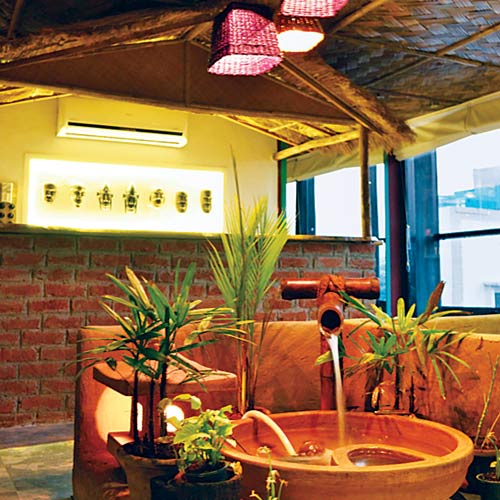Dzükou Tribal Kitchen, which serves Naga food, has
reopened in Delhi. The decor is the same and, thankfully, so is the
food, says Amrita Madhukalya
Just so that you don't buy into a misreading: Dzükou is now no longer at Hauz Khas Village. It has moved a few doors away to the Hauz Khas Main market, which along with the neighbouring Safdarjung Development Area (SDA) community market, has been the biggest beneficiaries of the exodus of good eating joints from Hauz Khas Village.
Adding its bit to the ever-growing universe of exotic cuisine in the capital, Dzükou, in its new avatar, is spacious (it boasts of parking space). But, once inside, you realise nothing much has changed. There is the same mural of three Naga tea garden girls, and almost the same menu. (Thank god for their pork ribs!)
The decor has changed a bit: interior designer Mukul Sood was roped in to do up the place. The result is a very traditional Naga ambience, with contemporary, minimalist chic. There is a six-seater and five eight-seaters, with the provision for Naga shawl blinds to accommodate more guests. There is a small fountain, where water spews from burnished bamboo, and the ceiling is dhokuwa, sourced from Assam, a traditional bamboo weave used as fences in village homes. The façade of a Naga hut stands in one corner of the room to serve as a bar that is still to open – the liquor licence is due soon. And there's a space for buffets, which owner Karen Yopthomi informs me, will also start shortly.
The menu is currently the old Naga menu, and there are plans to incorporate five dishes each from cuisines of all northeastern states.
We started with the smoked buff salad (Rs279), and the best-selling Naga pork ribs (Rs349). As with most northeastern food, the meat has just the right amount of chewiness and is smoked to perfection. The buff salad is a wee bit hot, and comes with fresh greens like yam leaves, Naga spring onions and fresh bamboo shoot. We were delighted that the succulent and crispy pork ribs had not changed at all and was in top form.
To wash down the starters, we called for the famed fruit beer (Rs149) next. It tasted better and headier than the pale beers one finds in Dilli Haat or in the eateries in North Campus, but we must warn you that it was really sweet.
For the main course, we ordered smoked buff curry (Rs319), chicken with fresh bamboo shoot (Rs319, there are alternatives of chicken and of dry bamboo shoot), a side dish of rosep aon (dry, Rs169) and pork anishi, a paste made of smoked yam leaves (Rs319). The smoked buff curry is not for the faint-hearted, there are generous dollops of raja mircha, known as the hottest chilli in the world, and fresh greens. The chicken with fresh bamboo shoot was full of flavour, and again, a bit hot. The rosep yon is an assortment of greens like bitter gourd, fresh bamboo shoot, yam leaves, Naga spring onions, Naga beans, etc. Our favourite amongst these was pork anishi — the smoked yam and the smoked pork has a character of its own, and you will most possibly reach out to more than one serving.
The mains also consisted of steamed rice (Rs99) and an assortment of chutneys — a smoked chilli-tomato-onion paste, raja mircha chutney with dry fish and raja mircha chutney with shredded beef (Rs129 each). It will need a warrior to survive the chilli-tomato-onion paste, but the raja mircha chutneys came with their own flavours. We strongly recommend the one with that came peppered with slivers of crispy roast beef.
Dzükou will also host musicians from the northeast, who will come and perform at the tiny platform.
The Tatseo Sisters performed last week, and Alobo Naga might perform in the coming few weeks.
Karen, who takes special care of the food cooked in the kitchen, sources her ingredients all the way from Nagaland. The smoked meats, the yam leaves, the axhone, the dry mushrooms, the Naga spring onions and the raja mirchi — all come to the capital on a train. And, I guess, that's what makes Dzükou's food so authentic and straight out of the lush valley in Nagaland. And oh, did we tell you that Naga food does not use any oil to cook us this storm?








0 comments:
Post a Comment